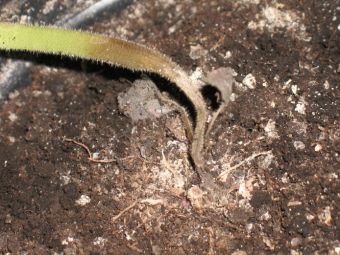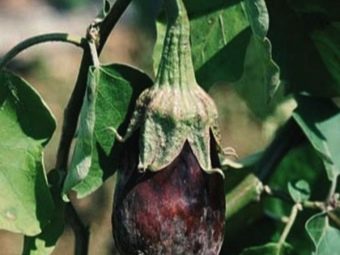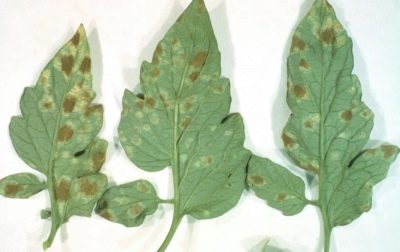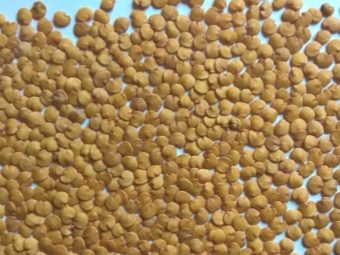What diseases have eggplant and how to treat them?
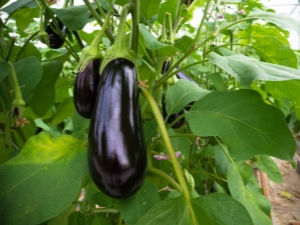
Despite the fact that eggplants are quite fastidious culture, require proper care and caring attitude, many gardeners appreciate this vegetable and grow it in their plots. However, various diseases that affect these plants can become a serious nuisance. In some cases, preventive measures help, but if the disease could not be prevented, you need to know how to properly recognize and treat it. This will be discussed in this article.
Causes of disease
The nightshade family, along with crops such as peppers and tomatoes, includes eggplants. However, these plants are much more gentle, for active growth they need certain heat indicators and soil moisture. A good harvest depends on many factors, for example, whether the place for planting is right, whether it is warm enough in the sun, whether the seedlings are plentiful, and so on. If conditions are not met, it can cause weakening of plants, reduction of their ability to bear fruit, as well as the emergence of various diseases.
Most often, with good care, eggplants are not susceptible to the spread of diseases and attacks of pests, but exceptions occur.
In general, the reasons for the plants to feel uncomfortable, there may be several and often gardeners can fix it.
- One of the main problems is the lack of light. This applies both to the culture located in the greenhouse and planted in open ground. This is dangerous because the stems of the fruit may thin, respectively, nutrients to the fruit comes less, so they develop worse and have a pale skin.
- Dangerous for eggplants and moisture deficiency. This problem is especially relevant when the fruits begin to ripen. If the fluids are not enough, they begin to crack, they can dry out. It should also be borne in mind that the culture does not like cold water, so it can rot and grow badly, which affects fruit production. Watering plants should be extremely warm water, and this should be done only in the morning and evening to avoid burns on the leaves under the scorching sun.
- If the soil lacks nutrients, it can be a problem with the leaves. They turn brown, due to a lack of potassium they can be curtailed, deficiency of phosphorus leads to stretching of the leaves, and a small amount of nitrogen - to their lightening. Saves in this situation the correct handling and feeding.
Disease symptoms and ways to deal with them
All diseases to which eggplants are susceptible can be divided into 3 types:
- fungal;
- bacterial;
- viral.
Consider the main ones in more detail.
Blackleg
This fungal disease leads to the fact that the stems of plants wither over time. Sometimes they can form a gray bloom, which is nothing more than spores of the fungus. Water and wind help them to be transported and infect neighboring shoots.
The raid spreads along the stalk, leading to its destruction. When the process reaches the roots, the plant dies. Moisture, rainy weather, and wet ground are very favorable for the spread of fungal diseases. Plants in greenhouse conditions are particularly susceptible to blacklegged.
Poor airing, late removal of the affected seedlings, active watering only exacerbate the situation. These conditions must be eliminated, after which the soil should be covered with wood ash. Then you need to spray the eggplants with such means as Baktofit, Fitosporin, Maxim, which kill the fungus. It should be borne in mind that sudden temperature drops badly affect eggplants, they become weaker, which helps the fungus to hit the plant.
When treating, follow the instructions for the drug and not violate the specified dosage, as well as protect the skin from the effects of the composition.
Late blight
Late blight also belongs to a number of fungal diseases. It affects not only the stem, but also the fruits and leaves. If rusty spots appear on eggplants, this is the main indicator of this disease and speaks of germination of fungal spores. The affected leaves should be immediately removed and disposed of, and the remaining plants treated with copper sulphate or bordeaux liquid.
Among the folk remedies in the treatment of fungal diseases, garlic infusion is popular.200 grams of the crushed product are poured with 3 liters of water and infused for 1.5-2 weeks, after which they are diluted with the same amount of water, and the crop is treated with this medium. Wood ash also helps to get rid of fungus.
Sclerotinia
The fungus that causes this disease is in the ground, therefore, initially affects the root system. The disease is also called white rot, since white bloom forms on the stem over time, and inside it - a kind of seals, which subsequently soften. This blocks access to food and leads to the fact that the fruit becomes watery, the leaves are covered with dark moist spots.
The disease is typical for young plants and can hit the fruit already during their storage. The main thing during treatment is to remove the affected areas, and to dust the remaining parts immediately with ashes. Bordeaux fluid and copper sulfate, as well as complex fertilizers will be useful.
It is also important to air the greenhouses and remove weeds in time.
Alternaria
This disease looks like round brown spots covering the surface of the leaf, which over time twist and can dry out. On fruits, it appears as depressed spots that become soaked and over time become more, until they merge. Vegetable softens and instead of purple becomes black or olive-gray.
Most often, the spores of the fungus enter through cracks and possible mechanical damage to the plant, develop well in the heat and at high humidity. Especially susceptible to this disease are late varieties of eggplants, as well as those fruits that grow from below. Copper sulphate, Horus, Antrakol, Fitosporin and other special compounds are used for treatment. Drying the soil will be useful.
Fusarium
If the plant is still affected, it must be removed, and the remaining bushes and soil treated with benzimidazoles. Most often the disease affects the plants in the greenhouse. This occurs mainly at the time of ripening. The fungus that lives in the soil, penetrates into the bush, clogs its vessels and contributes to the formation of toxins.
Spores can also get into the plant through cracks and mechanical defects, for example, if thorns were recently cut. Leaves from the very top twist, turn yellow, turn white, dry, wither and fall. Optimal conditions for the development of Fusarium - a temperature of about 22-27 degrees, as well as high humidity.
It can turn into a chronic form of the disease, as the mushrooms sustainably tolerate various treatments, therefore the main measure to combat them is preventive prevention in time.
Anthracnose
Most often affects eggplant planted in open ground. The disease is also dangerous for peppers and tomatoes, but it is also transmitted with plant residues from other crops.
On the leaves and fruits looks like brown spots in the shape of an oval. Over time, these spots become larger, merge, eggplant cracking. Protection includes spraying with copper oxychloride.
Cercosporosis
Also, this disease is called leaf-spreading of the leaves. It affects all parts of the plant, starting with the stems and leaves. Manifested in the form of small round specks, which, growing, lead to wilting of the leaf and its death. Since the process of photosynthesis in this situation is violated, this directly affects the fruits, they are small and do not develop fully.
The disease is transmitted by spores, water and wind are its main carriers. Infection can also occur through untreated garden tools. If you do not remove plant residues, spores can develop in them over the course of a whole year. In addition, the disease often spreads to pepper.
To get rid of this scourge Bordeaux liquid is used, as well as other compounds with similar spectrum of action.It is possible to increase the resistance of eggplants to cercopromic leaf spot by adding complex mineral fertilizers to the top dressing.
Fomopsis
This disease is called dry eggplant rot. It is often found in plants living in the open field, but greenhouses can not boast of its complete absence. Visually, the disease can be seen when the seedlings are just beginning to emerge, in its drilling and decay. If the shoots are more mature, the rot covers the root part of the stem.
On the leaves it looks like brown round spots with a pale center. Soon, the specks become covered with black dots, which can turn into small holes, but the fruits have depressed spots of the same color, with time they get wet. The spread of the disease leads to rotting of the fruit and the loss of the entire crop, as the flesh turns into soft rot, and the spores on it are manifested in a scattering of black dots.
Phomopsis is also unpleasant by the fact that it can visually appear after harvesting, for example, during its transportation or storage. Bordeaux mixture is used for treatment; fungicides containing chlorothalonil, prochloraz and mancoceb are also effective.
Bacterial spotting
Among the bacterial diseases of eggplants, bacterial spotting is one of the most common. It is caused by the bacterium Xanthomonas vericatoria and affects both the plants in the greenhouse and those planted in open ground. It can affect the eggplant in any period of its growth and ripening, affects all its parts.
It looks like this: on the leaves black specks of small size with a yellow border appear, on the stems such spots have an oblong shape, the fruits also have bulging dots with unpleasant watery edges around the perimeter. Over time, the dots increase in size, covering the entire fetus, and turn into ulcers. For a favorable course of the disease requires a high temperature, more than 25 degrees, as well as strong humidity. Bacteria can remain in seeds and uncleared plant residues.
This disease is dangerous because even in the case when the disease was defeated, it does not make sense to rely on a good harvest. The treatment itself often fails, so the only thing that can be done in this situation is to destroy the infected fruits in time and treat the soil with antibacterial agents.
When talking about viral diseases can not ignore the mosaic. It can be tobacco, ordinary and cucumber. The virus is stored in the remains of plants and can be transmitted through garden tools that have not been processed.
Also vectors can be insects and pests, such as aphids and whitefly. Transmission through the soil is quite rare.
Determine the mosaic is easy. It is a pale spot with a characteristic mosaic shape. Over time, these spots increase in size and die off. If the virus hit the eggplants, you can not count on a good harvest, the fruits do not develop well, have an irregular shape. One of the most unpleasant moments is that viral diseases are practically not treatable.
Phytoplasmosis
Another viral disease that affects primarily plants planted in open ground. However, since mid-summer, it is also dangerous for eggplants growing in greenhouses.
This virus is also called stolbur, it is quite strong, capable of infecting not only eggplants, but also such crops as tomatoes, peppers, potatoes, and often weeds. Its effect is visible on all parts of the plant. The leaves become small, often turn blue or have a pale purple hue, the flowers, like the stem, deform, the petals grow together and become faded, the fruits are small, hard, unpleasant in appearance, have few seeds.
The main carrier are cicadas.Externally, the disease can be confused with attacks of such a pest as a spider mite, but the symptoms are much more pronounced.
Prevention
It should be borne in mind that future crops may be harmed by insects, fungi, bacterial and viral infections. For some of them, there is no effective treatment, so you should think about how to prevent the problem. The Solanaceae family, which includes not only eggplants, but also peppers with tomatoes, is susceptible to the same diseases, which means that without the right crop rotation there is a risk of passing infections to neighboring crops.
The correct care of the soil helps to combat the occurrence of fungi and bacteria.
Before you begin planting seeds and seedlings, they need to be disinfected. Also, the ground should not be too wet and be in the shade. The possibility of sharp temperature fluctuations, increased acidity of the soil, as well as an excess of nitrogen fertilizers are extremely undesirable. In thickened plantings with frequent precipitations and high humidity, white rot is possible.
Another important point in the prevention is the removal of all plant residues, as well as the weeding carried out in time. When the harvest is removed, you should dispose of all the tops, because it can develop a fungus. As for greenhouses, they need to be regularly aired.
With fusarium, treatment most often turns out to be ineffective, which means that preventive measures should have a special place. There are specially bred varieties that do not wither, it is reasonable to use them. In addition, if the disease affected the planting earlier, the soil needs to be replaced and decontaminated. Disinfection of seeds will also be useful. Prevention measures for this disease include spraying with garlic tincture, whey or fungicides.
For diseases of the bacterial type, the main preventive measures are seed dressing, crop rotation, as well as disposal of all plant residues.
As for viral diseases, their treatment is ineffective in most cases, so preventive measures are the only way to protect and preserve the crop. If the plots on which eggplants are grown were susceptible to the emergence of diseases such as, for example, mosaic, plants should be treated with insecticides in the early period. Such drugs as “Mospilan”, “Aktar” are well suited. Since the virus is carried by insects, weeds should be disposed of as their favorite habitats, after which they should be sprayed with special formulations like Fufanon and Actellic.
If traces of the virus are found on plants, they should be immediately removed and disposed of. Well, be sure to monitor the treatment of seed, disinfection of garden tools, cleanliness of the soil. If you follow these simple recommendations, such diseases do not overshadow the life of gardeners and will not affect the crop yield.
The next video is about eggplant pest control.




